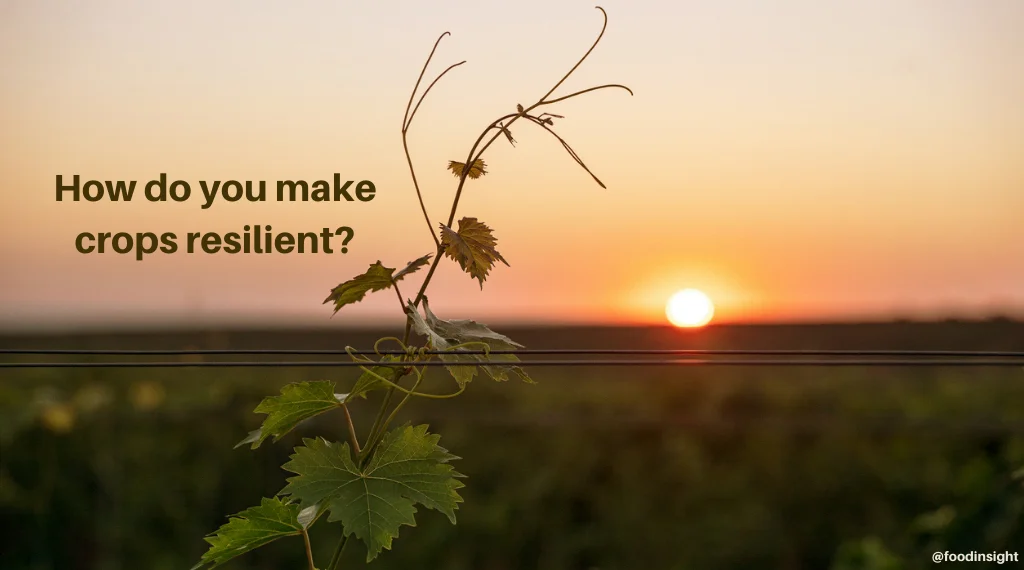
Shifts in weather patterns and harsh weather conditions are phenomena that humankind has been witnessing for many years. These occurrences can impact our day-to-day lives in many ways, particularly in the realms of agriculture, food production and food access. You’ve likely read about how climate change has been observed over decades, and how over these years the concentration of greenhouse gases in the atmosphere—mainly carbon dioxide—has risen considerably. Additionally, we’ve written about how many environmental scientific experts agree that climate change is happening and that humans are the cause.
While many industrial companies, public health stakeholders and members of the general public are employing climate-change mitigation strategies, utilizing different innovations, and changing their daily operations to lessen their impact on the environment, climate change is still present, and our growing population still needs to thrive and be fed. Thus, farmers have had to undertake new technologies to maintain food productivity. One of these new technologies is the development of resilient crops.
Climate challenges
There are three primary climate challenges that impact farming: seasonal shifts, ecological disturbances, and extreme weather and/or extreme weather events. All these occurrences impact the foundational needs of crops: water, sun and soil. They also affect the agricultural animals that survive and grow from crop consumption.
Seasonal weather predictability is a cornerstone of farming, and non-seasonal weather variability can pose many agricultural challenges. Shifts in seasonal weather can cause several problems, such as increased atmospheric carbon dioxide, increased length of the frost-free season, increased nighttime temperatures, and earlier and faster snowmelt-driven runoff, which can result in reduced summer stream flows (water supplies).
Ecological disturbances include incidents such as wildfires, landslides, flooding, windstorms and pest outbreaks. Disturbances often yield short-term landscape changes but can have very significant, longer-term ecosystem impacts. An ecosystem is an environmental area in which organisms and landscapes work together to form a thriving system. In an agricultural ecosystem, everything from the type of dirt to the bacteria species living in the dirt to the multitude of insects, animals and different crops atop the soil plays an important role in sustaining and maintaining a farm’s function and balance. If agricultural ecosystems are disrupted, crop yields can be considerably dismantled—which directly impacts food availability down the line.
Extreme weather is considered ecological disturbance’s “sister.” These two climate challenges are often directly linked. Weather-related extreme events typically are short-term and include heat waves, freezes, heavy downpours, tornadoes and tropical cyclones. In addition to these extreme events, there are other climate-related events that can last over a long period of time and can be the result of the accumulation of seasonal shift outcomes or disturbances. An example of a longer-term extreme event is drought resulting from long periods of below-normal precipitation or wildfire outbreaks. Like disturbances, extreme weather can have an extended impact on farming practices and natural resource availability—leading to farming productivity decline.
Rescued by resilient crops
Via farming advances, including the use of biotechnology and the development of resilient crops that are able to withstand various harsh conditions (that could otherwise obliterate harvests and food stores), farmers are able to recover from and/or be immune to the above-mentioned climate challenges.
Studies have found that supporting the growth of crops that can withstand climate challenges has shown great strides in helping farming productivity. As Acevedo et al. has noted, “For all countries, but especially those that rely on domestic agriculture production for food security, one of the most critical and proactive measures that can be taken to cope with food insecurity caused by unpredictable weather patterns is for farmers to adopt climate-resilient crops.” The need for resilient crops has grown even more for farmers (and the public) in the wake of the 2020 COVID-19 pandemic.
Here are some examples of biotech-derived and cultivated resilient crops that provide food to both people and animals around the globe:
Drought-tolerant crops
A widely used and key drought-tolerant crop is drought-tolerant corn (DT corn). This corn variety, available in the United States, was specifically designed for dry, drought-like conditions. DT corn is available in both genetically modified (biotech-derived) and non-genetically modified forms. These plants still need water, but they have been engineered to protect farmers’ yields in moderate drought years.
As noted by the U.S. Department of Agriculture (USDA), “DT corn varieties became available to U.S. farmers between 2011 and 2013. Decades of research on drought tolerance by crop breeders and plant scientists preceded the national commercialization of these varieties. Scientific gains in drought tolerance have been made in other crops, but corn has been a major focus of research because of its significant acreage and sensitivity to drought.” This impressive corn is among several different crops that are drought-tolerant. See a comprehensive list here, including a variety of crops such as beans, rice, watermelon, eggplants and peppers.
Salinity-tolerant crops
Climate change is expected increasingly to impact the salt content of river water (which is used for irrigation) and the surrounding soil. Some crops—such as cotton, barley, safflower and sugar beets—can normally flourish in higher-salinity water and soil, but the majority of crops cannot thrive in these conditions. However, scientists have developed genetically modified wheat and rice that can withstand higher levels of salt. In addition to allowing farmers to grow food in changing conditions, these varieties can relinquish more fresh water for drinking. This list gives more details on additional naturally occurring salt-tolerant crops.
The impacts of climate change can seem alarming, but with the continuous development of resilient crops and farming practices (as well as other industrial technologies) that aim to reduce the impact of climate-changing agents, a seed of hope has been planted for ensuring the continuous future health of our planet and humankind.




